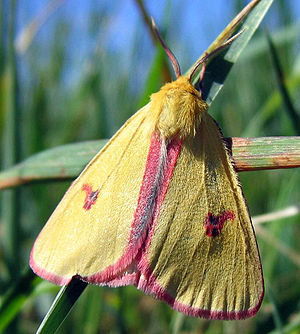Red rim bear
| Red rim bear | ||||||||||||
|---|---|---|---|---|---|---|---|---|---|---|---|---|

Red-rimed bear ( Diacrisia sannio ), male |
||||||||||||
| Systematics | ||||||||||||
|
||||||||||||
| Scientific name | ||||||||||||
| Diacrisia sannio | ||||||||||||
| ( Linnaeus , 1758) |
The red rim bear ( Diacrisia sannio ) is a butterfly ( moth ) from the bear moth family (Arctiinae).
features
The wingspan is about 25 millimeters. The males are bright yellow on the upper side with a red central spot on each wing. The hind wings are white with a z. Black transverse band on the outer edge partly dissolved into individual dots. Front and hind wings are edged in red with the exception of the rear edge of the hind wing. The much smaller females have orange forewings with red spots, while the hind wings are almost black and have a red border area. The eggs are laid in groups on the leaves of the forage plants of the caterpillars. The single egg is yellowish-white and hemispherical. The caterpillar is hairy black-brown to reddish-brown. It has a whitish center line with red dots. The caterpillar overwinters and pupates in spring in a web on the ground. The shiny red-brown doll has a cremaster with bristles.
habitat
The red-rimed bear can be found on moorland meadows , swamp forests, floodplains, on the edges of the forest, in sanctuaries or on clearings with grass and meadows. In the mountains it can be found up to an altitude of 2,400 meters.
development
The red rim bear flies in one or two generations, depending on the region and altitude. Adult butterflies are found for one generation a year from June to July. If there are two generations, the moths of the first generation fly from May to June. The second generation moths can then be found from July to August. During the mating season, the females attract the males with a sexual attractant. The first generation caterpillars are found from September to May and the second generation from July to August. The moths are diurnal and nocturnal. You come to light. However, the females of the red rim bear are very slow to fly. The caterpillars, on the other hand, are exclusively nocturnal. The caterpillar overwinters.
Food crops
The caterpillars eat among other things:
- Bedstraw ( Galium spec. )
- Plantain ( Plantago spec. )
- Common dandelion ( Taraxacum sect.Ruderalia )
- Willowherb ( Epilobium spec. )
- Nettle ( Urtica spec. )
Flight times
The moths fly from June to July, the caterpillars appear from August and after wintering until May.
Occurrence
The distribution area of the red rim bear stretches across Europe (in the north up to the 68th parallel ), across northern Asia to Japan.
Danger
The red rim bear population seems to be declining, at least regionally. In some German federal states, the species is therefore on the warning list (the species is endangered in future if its habitat is further destroyed) or is already classified as endangered.
swell
literature
- Walter Forster , Theodor A. Wohlfahrt : The butterflies of Central Europe. Volume 3: Weirdos and Swarmers. (Bombyces and Sphinges). Franckh'sche Verlagshandlung, Stuttgart 1960, DNB 456642196 .
- Günter Ebert: The Butterflies of Baden-Württemberg Volume 5, Moth III. Ulmer Verlag Stuttgart 1997. ISBN 3-800-13481-0
- Manfred Koch : We determine butterflies. Volume 2: Bears, Spinners, Swarmers and Drills in Germany. 2nd, expanded edition. Neumann, Radebeul / Berlin 1964, DNB 452481929 .


